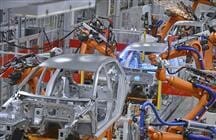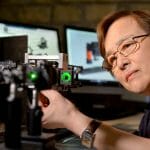The continued focus on improving energy efficiency and sustainability remains a major driving force for innovation in mechanical and electrical engineering arenas. Improved speed control using variable speed drives (VSDs) has produced a significant energy saving, but the next step needs to be much bolder – the implementation of a direct current (DC) grid within industrial premises has the potential to reduce operating costs and take advantage of renewable energy sources.
The German Electrical and Electronic Manufacturer’s Association [Zentralverband Elektrotechnik und Electronikindustie (ZVEI)] initiated the DC-INDUSTRIE research project along with 21 industrial companies and four research institutes. Together they are jointly working on the project to implement the energy transition in industrial production and, therefore, bring more energy efficiency and energy flexibility into industrial production.
Among those involved is Bauer Gear Motor, which is part of the Altra Industrial Motion Corporation, and Karl-Peter Simon, Bauer’s Managing Director, who is taking a leading role in the research.
Karl-Peter Simon: “This research project has the potential to benefit a large number of manufacturing industries, with one large automotive company already planning to implement some of the recommendations in a new test facility. Bauer is keen to use its expertise to help deliver this innovative vision and make a significant contribution to improving energy efficiency.”
In the industrial sector, electric motors account for about 70% of electricity consumption and are thus the most significant load of electrical energy. Reducing the energy requirements of these drive systems by increasing their efficiency contributes to an equivalent reduction in CO2 emissions.
Since 1st January, 2017, all new 3-phase motors sold in Europe with rated power from 0.75 to 375 kW must conform to energy efficiency class IE3, or alternatively IE2 for use in frequency inverter operation. These efficiency classes are specified for three-phase asynchronous motors operating at nominal speed and nominal torque. However, experience has shown that an energy efficiency regulation of a component can only sustainably reduce energy in certain operating modes.
With this in mind, the DC-INDUSTRIE project, by means of direct current networks, aims to support both the energy transition and energy efficiency, as well as Industry 4.0. The project is sponsored by the Federal Ministry for Economic Affairs and Energy [Bundesministerium für Wirtschaft und Energie (BMWi)] and has a term of three years.
Inefficiencies in speed control
The advantage of using a frequency inverter is the continuous adaptation of the motor speed to the actual need, which can very often also lead to energy savings. A frequency inverter is supplied with the alternating current, which is first converted into direct current using a rectifier. The direct current is then converted into alternating current with variable frequency and voltage through a voltage feed inverter in order to electronically change the speed of a three-phase motor.
However, if the three-phase motor is operating in the braking mode, e.g. in a crane that is in lowering mode, the energy flow changes. But, this energy cannot be fed back into the grid by the frequency inverter because the input rectifier only allows the energy to flow in one direction. Therefore, the energy that is fed back must be dissipated via the direct current voltage circuit of the frequency inverter.
For this purpose, a brake chopper is connected to the intermediate circuit. This monitors the intermediate circuit voltage with regard to the voltage level. If the intermediate circuit voltage exceeds a set threshold value, the brake chopper switches the braking resistor between the positive and the negative pole of the intermediate circuit. This is usually an additional external braking resistor that converts the braking energy into heat energy.
Reducing harmonics issues
The increasing use of frequency inverters to control motor speeds has led to problems with mains effects, causing harmonics and distorting the voltage. There is no standard solution for harmonics, since each grid and its electrical load are very different. Ultimately, the operator is responsible for the voltage quality of its own production facilities. If frequency inverters or other devices with power electronics are increasingly installed, grid effects will increase.
The challenges presented show that a further increase in the use of inverters for the flexible control of electric motors is desirable and very often even necessary. This is the only way to improve both production processes and energy efficiency. However, line perturbation due to harmonics and equipment costs limit the increase.
In order to achieve significant progress in energy efficiency and system cost optimization, new approaches are needed. To enable energy efficiency, energy transition and Industry 4.0, new grid structures are required.
Creating the solution
The new network structure is based on an alternating current supply, which provides the direct current power supply for production plants via a central rectifier. Active grid filters are integrated into the central rectifier to ensure the voltage quality harmonic requirements.
The direct supply of the frequency inverter with direct current means that all decentralized energy conversion is no longer needed. Since central energy conversion (from AC to DC) is significantly more efficient, conversion losses are significantly reduced.
Through the direct supply of all electric motors via a frequency inverter with direct current power supply, all installed motors are connected via a common direct current voltage grid. Furthermore, a direct current voltage network essentially only causes ohmic transmission losses. Compared to an alternating voltage network, the capacitive and inductive line losses are eliminated.
In addition, the central direct current voltage network offers the possibility of integrating photovoltaics directly at the direct current voltage level. In this case also, conversion from DC to AC is not required to be done by an inverter. This grid infrastructure offers the possibility of optimizing the purchase of energy and to stabilize the grid.
Through the elimination of the input rectifier and the grid filter with frequency inverters, these can be designed more cost-effectively and more compactly. This simplifies integration into the motor, which can significantly increase the degree of acceptance. Variable speed motors allow for a reduction in variants and energy savings. They provide status signals from all DC-fed drivers, which are of great importance for flexible and safe production control.
Grid management makes it possible to optimize operational management in terms of energy costs. The accessible information enables preventive production control measures to significantly increase the availability of production. This is a prerequisite for the successful implementation of Industry 4.0.




